
by TCW | Oct 18, 2019 | Uncategorized
I used to find the Tudors ever so confusing. Henry with all those wives; the two daughters that everybody remembers and the son that everybody forgets; so many queens called Katherine (or variants thereof) and one too many called Mary. And who was Lady Jane Grey and how did she get to be the Ten-Day Queen?
Fortunately, I’ve just finished reading Gemma Lawrence’s The Bastard Princess. I did feel it was less a novel than a literary form of that popular television genre, the drama documentary. The result, though, is that despite its limitations as literature I now feel I understand a lot more about the history of those turbulent times. That turned out especially convenient as last week I went to see the Bacton Altar Cloth at Hampton Court.
What’s the Bacton Altar Cloth and why is it at Hampton Court?
The Bacton Altar Cloth is, as it sounds, a cloth that covered the altar at Bacton Church in Herefordshire. Like a lot of altar cloths, it’s a richly decorated piece of fabric. For over a hundred years it’s been hanging behind glass on a wall of the church because of its age. It was associated with Blanche Parry, who was the Chief Gentlewoman of Elizabeth’s Privy Chamber, who came from Bacton. Only recently it has been identified as being made from fabric cut from a dress.
In Tudor times there were strict, legally enforceable, rules on who could wear what sorts of cloth and the presence of silver thread in the fabric meant that it must have been worn by a very high status individual. The quality of the work and its similarity to dresses shown in contemporary paintings of Elizabeth suggest that the dress would have belonged to the Queen herself and that the fabric was gifted to the church after Blanche Parry’s death.
I was lucky enough to get a very close look at the cloth and to be able to admire the amazing embroidery on it.
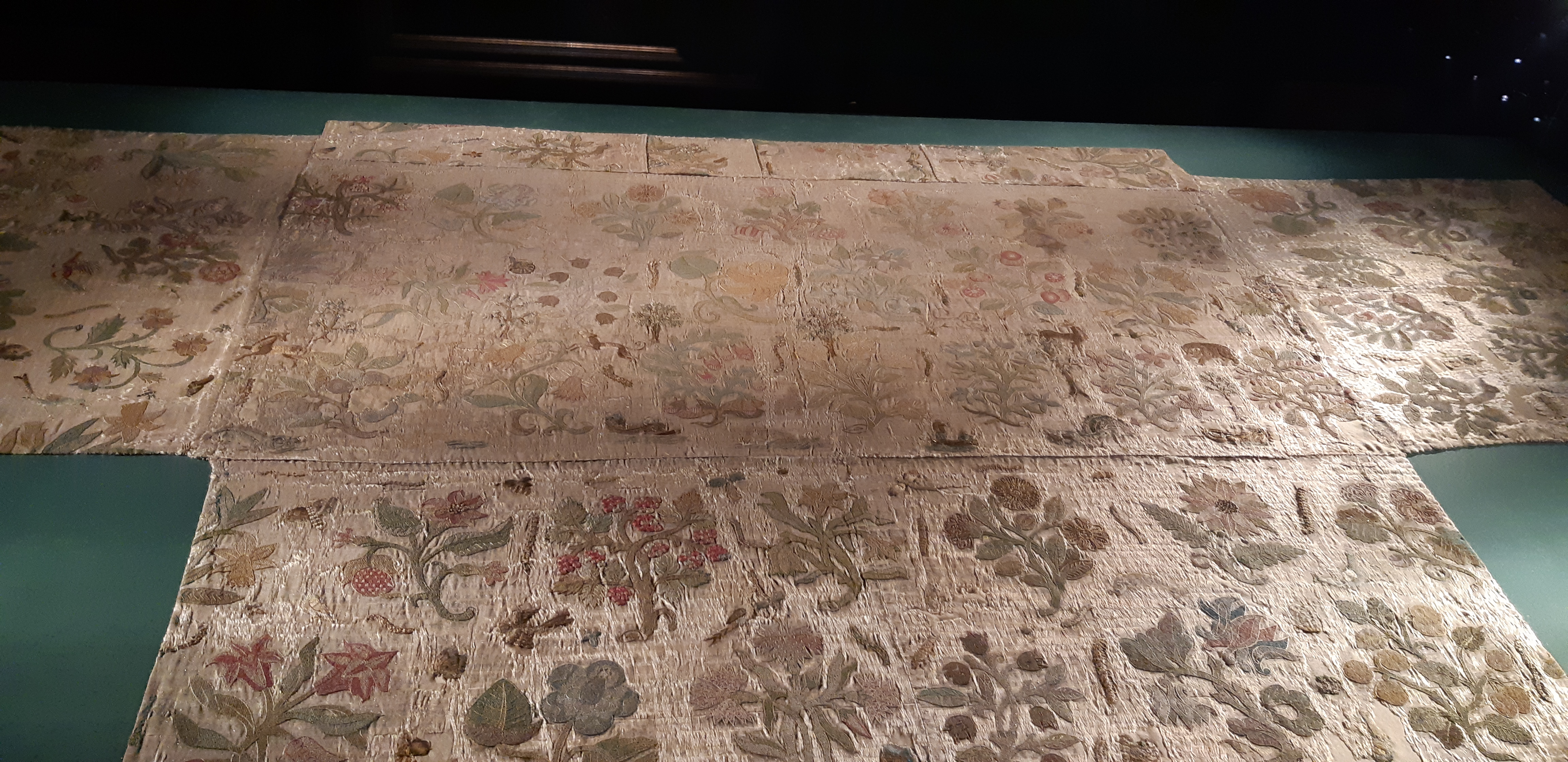

Being able to look at fabric that was almost certainly worn by Queen Elizabeth provides an astonishingly direct link with the past. It made me particularly appreciate the understanding I had got from Gemma Lawrence’s book.
Of course there are lots of other links to Elizabeth at Hampton Court. When I was there we even had an Elizabethan lady talking about them.

I was particularly intrigued by this painting showing Henry with his family, which Lawrence discusses in her book. It’s a completely imagined scene because it shows Edward as a young man and features his mother, Jane Seymour, who died very soon after he was born.
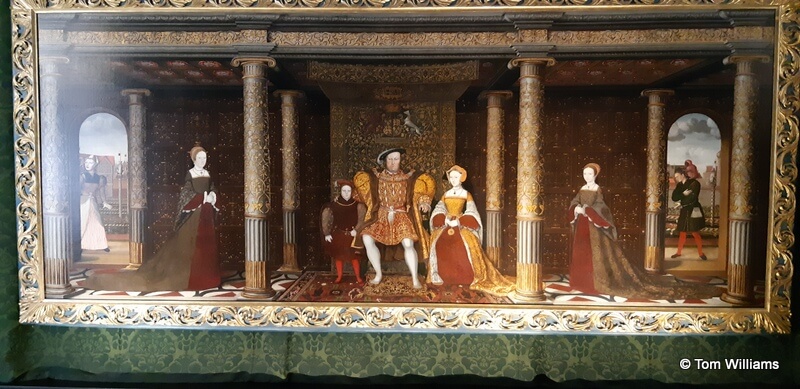
Elizabeth is the figure on the right of the picture. In The Bastard Princess, Lawrence has Elizabeth asking the painter to make sure that the jewellery she is wearing is not too obvious because it might have been seen as treasonous by the king. That made me look very carefully at the figure of Elizabeth.
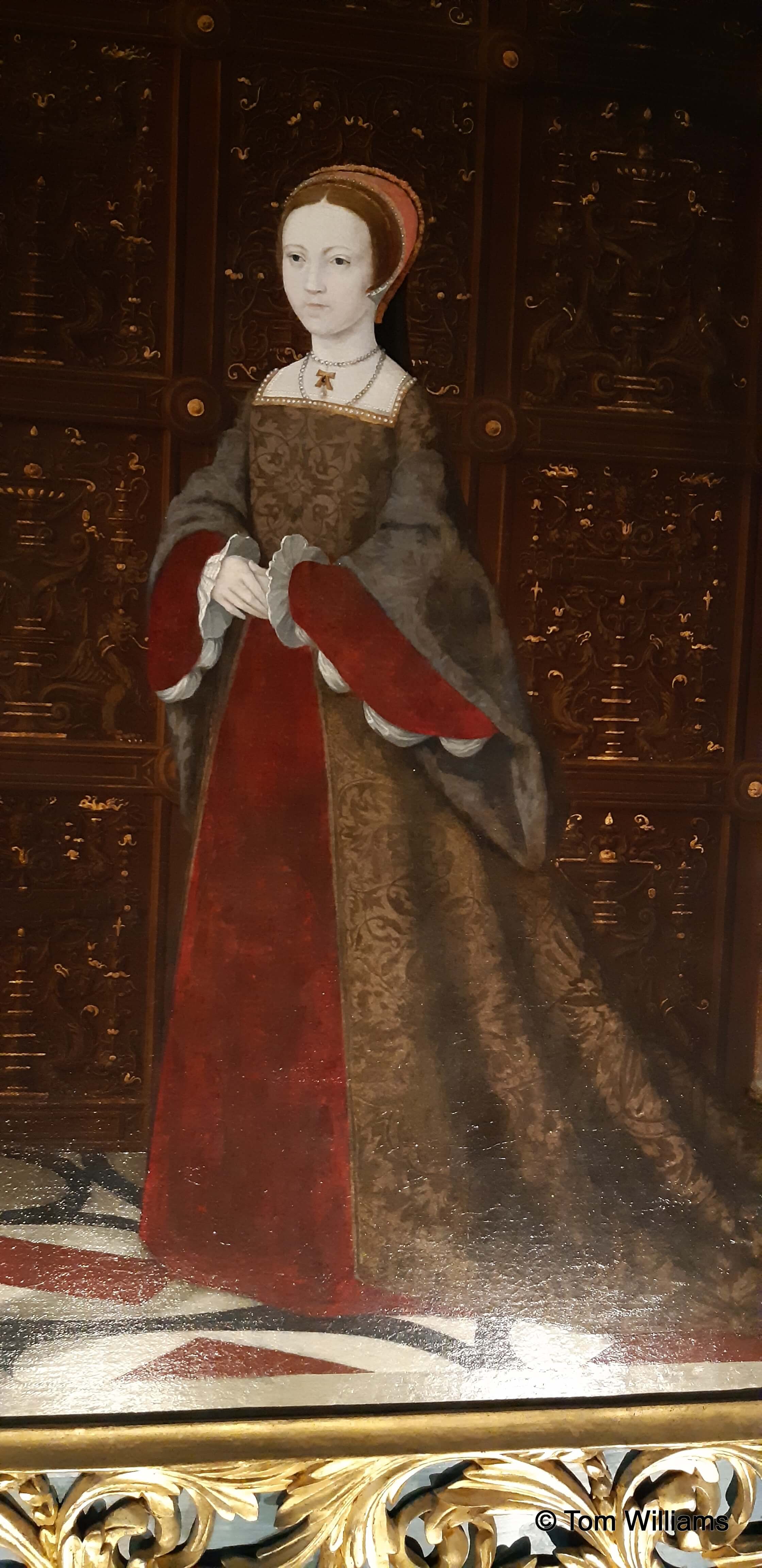
Do you see the necklace? Here’s a closer look.
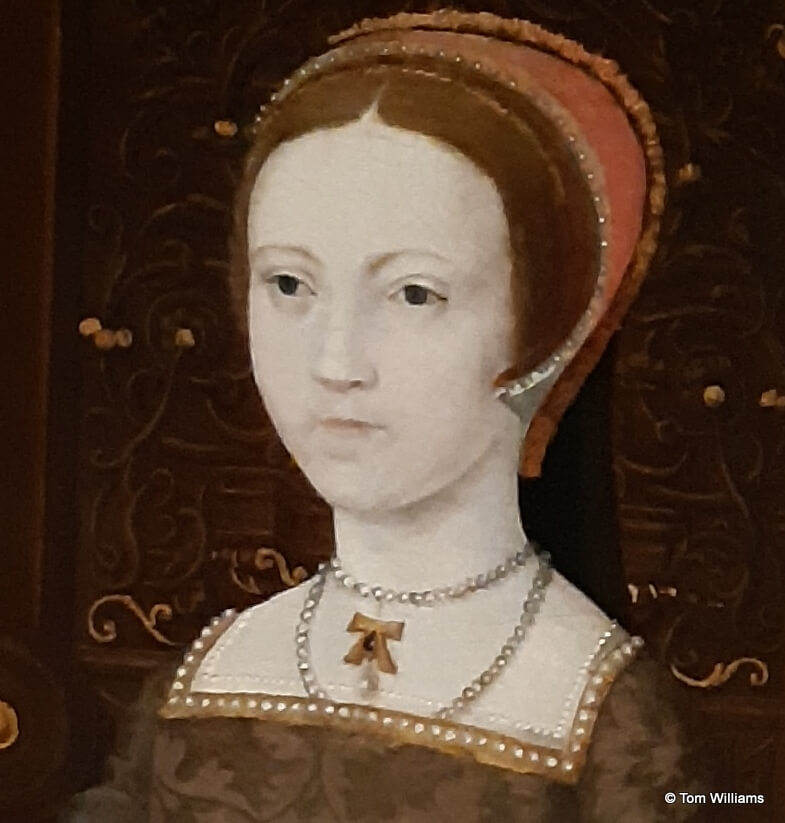
The letter ‘A’ is clearly visible – a remembrance of her mother (in the book it actually belonged to her mother), the woman Henry had executed as a traitor.
Elizabeth’s choice of jewellery says a lot about the woman. She was strong-minded and courageous. (According to staff at Hampton Court she was also short-tempered and could be vicious, aspects of her character that Lawrence only touches on.) Thanks to Lawrence’s book I understood a lot more about the woman and I knew what to look for in that painting.
If you want a readable introduction to the period, I recommend The Bastard Princess. If you want to get a real feel for court life then, you really should visit Hampton Court. If you get the chance to see the Bacton Altar Cloth, do make the effort. It’s on display until 23 February 2020.
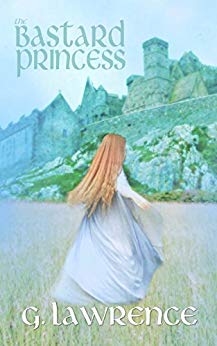
A Word from our Sponsor
If you enjoy historical writing from a rather more recent period, could I point you at my own books? There are three novels about James Burke, a spy in the age of Napoleon. They are first and foremost adventure stories, but you’ll find yourself learning quite a lot about politics and warfare at the time. Another series of three novels (The Williamson Papers) takes a rather more serious look at Britain and its empire at the mid-19th century height of the colonialist enterprise. You can find out more about all my books on my books page on this site or on Amazon.
by TCW | Oct 8, 2019 | Book review
This is a follow-up to Weird War Two which I reviewed for the Whispering Stories Book Blog back in 2016. I enjoyed that, so the authors sent me a copy of this one to see what I made of it.
The short answer is that it is remarkably similar to the first one. I had thought that they might be scraping the bottom of the barrel, having used up all the best stories, but it turns out that besides killing millions of people, destroying many of the great cities of Western Europe, and wreaking economic havoc on an unprecedented scale, World War II provided an almost endless source of unlikely yarns.
There are stories of great heroism, some of which deserve to be better known. The defiance of those Jews who fled to the woods and raised guerrilla forces against the Nazis is not remembered as it should be.
There are, inevitably, stories of animals that fought alongside the troops – the most unlikely being a bear that fought with the Free Poles. More tragically there is the account of how hundreds of thousands of pets were put down, ostensibly to aid the British war effort.
There are one or two stories that I have never heard before, but which ring horribly true. The fact that Jesse Owens was not insulted by Hitler, but was refused a place at the White House reception for victors is quite shocking. Some other stories, though, are definitely not true. I really want to believe that Polish cavalry charged a German armoured column, but I have met historians who have traced this one down to the misreporting of an incident witnessed by an Italian newspaper correspondent. It should be true, but sadly it isn’t.
There are stories of criminals sheltering in the London blackout and German frauleins being taught how to make an SS husband happy (and no, sex was very definitely not on the curriculum). Anything that is even loosely associated with the war seems to be grist for the authors’ mill.
As with the first book, this one adopts a remorseless “factoid” approach that is well suited to the interests of the Internet generation. It’s designed to be dipped in and out of, but it’s easy to read much more at a time than you meant to.
There are occasional references to sources that have more information, but generally there is an absence of footnotes and you have to take much of what you read on trust. This isn’t a “serious” book about the war but rather, like the BBC, something that seeks to educate, inform, and entertain at the same time. On the whole I think it does this rather well.

by TCW | Sep 17, 2019 | Book review
This is the second of M J Logue’s books about Major Russell and his young wife, Thomazine, and I’m happy to admit that I’m a fan. What I love about books is the characters and their relationship. Essentially these are love stories for grown-ups. This is still more true of A Deceitful Subtlety than the first book, An Abiding Fire, for the Russells are now settled in the Chilterns, concentrating on the rearing of sheep and raising a family. Respectability beckons, though theirs is still a passionate relationship.
It still felt odd, to be quite as bare as an egg – without even your shift – in the middle of the afternoon. Thomazine would have thought she would grow used to it by now, but it seemed not. No matter how much she found herself tangled up in bed sheets in the middle of the day, it still felt wicked.
We follow their falling outs and their making up, their misunderstandings and their struggles to iron out the wrinkles in their relationship. There are more of them than usual, for Thomazine is pregnant and moody and her temper is not helped by the sudden appearance of a woman who may, or may not, be an old flame of her husband’s. When husband and old flame have to journey to Bruges, Thomazine goes too, braving sea-sickness and the funny foreign ways of the Dutch so that she can keep an eye on her man.
There’s a nice sense of ‘foreignness’ to Bruges and an interesting picture of the English émigré community there, though I got little sense of what Bruges itself was like, which is sad as much of the town (a UNESCO World Heritage site) still stands and its beauty deserves to be celebrated.

Why are they in Bruges? I’m honestly not quite sure. There is a notional reason, but as with much of the plot, it didn’t quite make sense. This is, to be honest, not a book you read for its plot. In fact, I was completely bemused about a lot of it (no details because of spoilers) until I read the very long and fascinating historical note. It’s clear that Logue has researched her period extremely well, but if you don’t already have a definite grip on some minor characters of the time, you’ll likely have no idea what’s going on for much of the book. Who is William Scot and why are we looking for him? The historical note explains, but in the novel itself we are just constantly assured that he is a man of mystery.
“I would have said to you that there was not a man in this city about whom I did not know something, even if it were only that he keeps a second household in lodgings off the Mariastraat, or favours this tailor over that. I know nothing at all about Mijnheer Scot, and that troubles me. No one speaks of him, no one at all. He is like a man with no face, you know? He is alive, he breathes, so much I know. But no one speaks of what he is as a man.”
This does leave rather a hole where one of the main characters should be – an irritation that becomes more marked as it turns out that another person we meet is a fascinating historical character who is lost in a rather insubstantial sub-plot. It does raise questions though – like why are people so concerned about a man of very little importance while showing so little interest in somebody of real significance and – probably more relevantly to a writer – somebody that the reader will have heard of?
No matter. In some books the slightly rickety plot would be a real problem, but fans won’t be reading it for the plot. We want to know if Thomazine’s pregnancy will end safely, or if the scheming minx who started this all off will have her wicked way with Russell. (She won’t, of course, but will Thomazine believe this?) We may even end up caring about the latest addition to the cast – a rather repulsive small black dog who I fear we are all destined to come to love.
If all the domesticity gets a bit cloying (I didn’t think so, but it’s possible someone might), be assured that there is violence and sudden death and even torture (though of an anonymous individual in what are literally “noises off”). You may be confused at times, but you won’t be bored and you will (I hope) lose yourself in the love story.
And did I mention that Logue just writes really well? I show my age by caring about this in a world of plot-driven stories where no sentence runs to more than fifteen words and the vocabulary is deliberately unchallenging. Here, for no reason at all, she is describing a bit of excitement while they are penning their sheep to be shorn. If you’ve ever watched (or tried to help) as sheep are penned up, this will have a horribly familiar ring to it.
A chalky-blue butterfly settled briefly on Thomazine’s wrist, its threadlike legs tickling her hot skin, and she smiled down at it. Had she not been looking down, her eyes would not been caught by the old bellwether. A cunning villain, that sheep, with eyes as yellow and knowing as the Devil’s and twelve years of malevolent experience under his fleece. His witless ladies were milling and bleating in panic, but he’d been here before, that one. His baleful slotted eyes met Thomazine’s.
And he was out, the hell-spawned eunuch, forcing his scrawny besmottered flanks through the meagre gap in the hurdles. Where he went his ladies followed, and suddenly there was a flood of pounding hooves as the rest of the flock went with him.
If you don’t love those paragraphs, this probably isn’t a book for you. But if you do, you’re in for a treat.

by TCW | Sep 10, 2019 | Book review
Marilyn Todd’s Snap Shot is described as a Victorian mystery. The thing about the Victorian period is that it really is very long. I was, at first, confused by the box Brownie cameras and the telephones, and a general feeling that we were, perhaps, more in Edwardian than Victorian times. The answer is that we are in a Victorian mystery, but only just. No date is given in the book, but the arrival of the box Brownie pins it down as about 1900.
1900 is a little outside my era: I’m more of a mid-nineteenth century writer myself, but Todd does seem to have a strong sense of period, although occasional intrusions by an authorial voice from the 20th or 21st century can be off-putting. When we are told of one character that “the V-sign he flashed wasn’t for victory” we are firmly in the Second World War or after. A phone might have “rung off the hook” in 1900, but it’s very unlikely – it’s definitely an idiom from the second half of the 20th century and while women nowadays may often complain of being “objectified” this isn’t a term that was much used in the period the book is set. Todd never puts these phrases in the mouths of her characters, but she would be better off avoiding them altogether. On the other hand, she often captures the period with beautiful images that gives a sense of the times without beating us around the head with “period detail” to prove how carefully it was researched (though it clearly was researched very carefully). Take this example, when a character takes a cab ride:
He could walk. It was only a mile. But there was something calming about the rocking of the hansom. The rhythmic clop-clop-clop of horseshoe against cobble. The smell of freshly polished leather.
Todd writes very well, with a lovely use of unlikely metaphors.
On the table, bluebells from the Common threatened to wilt but so far hadn’t plucked up the courage.
Or, of a restless man, our heroine watched him “dart about like a wasp with the runs”.
Ah, yes, our heroine. The story is told mainly from her point of view and, fortunately, she is a sympathetic character – a woman making her way in a man’s world. The difficulties put in the way of women in 1900 are spelt out but gently woven into the story. For example, it was legally difficult for a woman to run her own business.
Timbered Tudor buildings overhung the cobbles, rickety and narrow, with signs above the shops creaking in the wind. David Hart & Sons Pharmaceuticals, est 1823. Js. Simpson, Family Butcher. Thos. Payne, Barber. You could be forgiven for wondering if women actually existed.
Even to rent rooms for her work, she needed to find a man to vouch for her.
… Oliver, of course, signing the paperwork, women being too weak and too stupid to manage such matters themselves.
Julia McAllister, though, is not to be put off by these obstacles. She is gutsy, beautiful and, for 1900 has a very open mind – but as a photographer of dirty postcards, this is definitely a good thing.
Somebody is murdering Julia’s models and trying to frame her for it. Julia needs to find out who the real murderer is before the dangerously handsome Detective Inspector Collingwood arrests her.
The plot bowls along with plenty of gruesome deaths and a little bit of sex to keep the pages turning. Finding out whodunnit came as a surprise, but not so much of a surprise as to make me feel cheated. Thinking about it, there may have been the odd tiny gap in the plot, but far less than in the average TV detective story and, really, who is going to give it quite that much attention? It’s frothy and it’s fun and it has a convincing historical background. By the end, Julia is ready to leave the country, but I rather suspect she won’t. This book is set up for a run of sequels and I look forward to reading them.

by TCW | Aug 27, 2019 | Book review
Round and Round is a novella. People don’t seem to take novellas seriously. Stephen King suggests (and surely he should know) that the novella just doesn’t appeal to commercial publishers. For King, books between around 20,000 and 40,000 words (Round and Round is 36,000 words) fall into “a really terrible place, an anarchy-ridden literary banana republic called the “novella”. There is, he points out, nothing at all wrong with the novella, artistically speaking.
“Of course, there’s nothing wrong with circus freaks, either, except that you rarely see them outside of the circus.” [Writing in the Afterword to Different Seasons]
The problem is that the things are practically unsaleable – something I’m all too aware of, having just written a 32,000 word novella of my own which is kicking around while I try to decide what to do with it.
The demise of the novella as a commercially viable form is sad – and probably foolish too. I’ve read too many books recently where a perfectly decent 35,000 word story has been padded out to make a 70,000 word novel which really hasn’t been very good. Also the growing popularity of e-books and the increasing demand for instant entertainment, which can be consumed and enjoyed at one sitting, means that there is surely a market for these things, if only online.
Fortunately, Terry Tyler publishes independently, so she doesn’t have to worry about whether her books are “commercially viable” or not. As a result, Round and Round is out in the world, available on Amazon for just 99p.
Tyler’s heroine is Sophie Heron. She’s heading rapidly toward her 40th birthday and realising that she doesn’t really love her husband, Chris. Where did it all go wrong?
The answer, she decides, is that it was when she was 24 and got four Valentine cards. One was from Chris. She chose him, and now she is sure that was a mistake.
Thanks to a little magical realism, courtesy of her dead aunt Flick (clearly some sort of witch, but the good kind), Sophie is able to discover what her life would have been had she chosen each of the other three.
I won’t spoil the book by telling you what happens. It’s a lightweight romance well-suited to its 32,000 words. In fact, I think it could have been a little shorter. The setup (the 24-year-old Sophie has gone on a miracle diet and suddenly become irresistibly attractive to men) is longer than it needs to be. I’m happy to know that she has four suitors – I don’t need to know how she got there. Once we’re into the story proper, it bowls along and, rather to my surprise I find myself caring about Sophie’s choice. It’s never going to be (like the other Sophie’s Choice) a major novel of ideas, but Tyler’s prose, which is consistently smooth across all her books, makes it a really enjoyable way to spend a long train journey.
There’s a lot more to the story, too, than meets the eye at first. Is there really The One waiting for us if we can only sort out our lives? Or is there another one along just behind if we mess up the first time? How much of our life-long happiness is based on just luck, and how much is down to our own efforts? As Sophie sees how life might have panned out if she had chosen differently, she discovers that not only her life, but those of the men she knew, can change for better or worse according as to the partners they choose – or who choose them.
I’ve read many much more “serious” books that have made me think about life less than this one. My own unfortunate Beloved has heard so much about it she’s threatening to read it herself. She’ll probably enjoy it. So will you.












